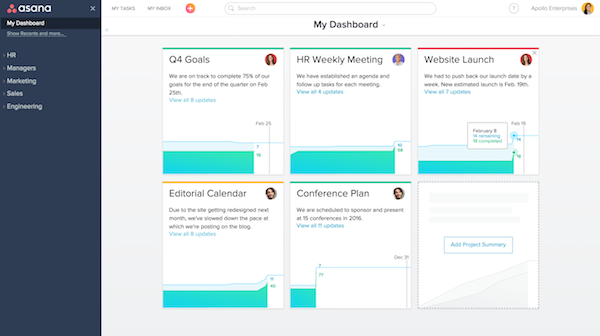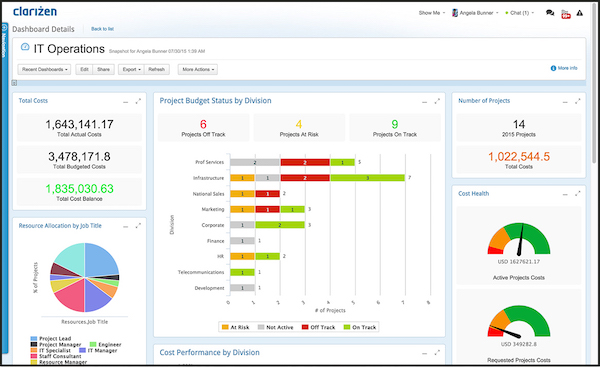Find the best Project Tracking Software
Compare Products
Showing 1 - 20 of 294 products
Sort by
Reviews: Sorts listings by the number of user reviews we have published, greatest to least.
Sponsored: Sorts listings by software vendors running active bidding campaigns, from the highest to lowest bid. Vendors who have paid for placement have a ‘Visit Website’ button, whereas unpaid vendors have a ‘Learn More’ button.
Avg Rating: Sorts listings by overall star rating based on user reviews, highest to lowest.
A to Z: Sorts listings by product name from A to Z.
monday.com
monday.com
monday.com is an award-winning work and project management platform that helps teams of all sizes plan, prioritize, manage, and execute their work more effectively. The platform offers solutions for a wide range of use-cases such...Read more about monday.com
Adobe Workfront
Adobe Workfront
Adobe Workfront is a collaborative work management solution that addresses the challenges of disconnected teams, siloed tools, and the relentless pace of enterprise work. Workfront includes capabilities to capture and plan, assign...Read more about Adobe Workfront
BigTime
BigTime
BigTime is an online time and billing solution designed to serve professional service firms like accounting, engineering, government contracting, legal and IT services. The integrated solution offers features like time and expense...Read more about BigTime
Wrike
Wrike
Wrike is a cloud-based project management platform for teams of 20+ that is suitable for both large enterprises and SMBs. It supports remote work for various teams. This solution comes with Gantt charts, calendars, workload view f...Read more about Wrike
Talk with us for a free
15-minute consultationSoftware Advice is free because vendors pay us when they receive sales opportunities.
This allows us to provide comprehensive software lists and an advisor service at no cost to you.
This allows us to provide comprehensive software lists and an advisor service at no cost to you.
Meet Eric, a software expert who has helped 1,534 companies select the right product for their needs.
Talk with us for a free
15-minute consultationSoftware Advice is free because vendors pay us when they receive sales opportunities.
This allows us to provide comprehensive software lists and an advisor service at no cost to you.
This allows us to provide comprehensive software lists and an advisor service at no cost to you.
Tell us more about your business and an advisor will reach out with a list of software recommendations customized for your specific needs.
STEP 1 OF 4
How many users do you have?
kintone
kintone
Kintone is a cloud-based, customizable workflow management platform suitable for businesses of all sizes. The key features of the solution include compliance management, approval process control, forms management, event monitoring...Read more about kintone
WorkOtter
WorkOtter
WorkOtter™ is purpose-built, by Project Managers for Project Managers, and helps PM professionals to deliver more successful project outcomes and align their work to the strategic objectives of the organization. Our solution is si...Read more about WorkOtter
Project Insight
Project Insight
Project Insight (PI) is award-winning work & project management software that helps companies manage and visualize projects, allocate personnel, streamline accounting, and track what work is being done throughout their entire orga...Read more about Project Insight
Smartsheet
Smartsheet
Smartsheet is a work execution platform and collaboration tool with a familiar spreadsheet-like interface that helps teams plan, track, and manage projects in real-time. Smartsheet features include a range of project management to...Read more about Smartsheet
Scoro
Scoro
Scoro is a comprehensive work management software specifically designed to cater to the unique needs of service businesses that have grown weary of dealing with disjointed systems, unpredictable workloads, and shrinking profit ma...Read more about Scoro
Ravetree
Ravetree
Ravetree is a cloud-based project management solution with integrated resource planning, customer relationship management and time and expense tracking capabilities. The solution helps users manage project workflows, task assignme...Read more about Ravetree
Workzone
Workzone
Workzone is a project management solution that offers document management, project collaboration, customizable reporting, resource and task management and time tracking. The software is cloud-based and offers automated emailed rep...Read more about Workzone
KolApp
KolApp
KolApp is a project management solution designed to ensure project success. With a focus on project, portfolio, work, and task management, KolApp offers a comprehensive suite of features to streamline project organization, plannin...Read more about KolApp
Proggio
Proggio
Proggio is a project and portfolio management solution for professionals. -No more confusing waterfall charts that scroll endlessly down a page. Instead, understand the full scope of your elaborate portfolio in just one quick sn...Read more about Proggio
Oracle Fusion Cloud ERP
Oracle Fusion Cloud ERP
Continuous change requires continuous innovation Tomorrow’s leaders are those most capable of adapting to change today. Oracle Fusion Cloud ERP is a complete, modern, cloud ERP suite that provides your teams with advanced capabil...Read more about Oracle Fusion Cloud ERP
Kantata
Kantata
The Kantata Professional Services Cloud is purpose-built to help organizations with 50 to 5000+ employees unify resource management, project management, financial management, business intelligence and team collaboration all in one...Read more about Kantata
Factor AE
Factor AE
Factor AE is a simple, affordable software that helps architecture and engineering firms manage projects, resources, invoicing, and overall profitability. The features in Factor A/E were specifically designed to alleviate common p...Read more about Factor AE
Trello
Trello
Trello is a visual collaboration tool for planning tasks and projects. While commonly used by agile software development teams, the solution is also used in other departments such as marketing, sales, support and HR. The web-based...Read more about Trello
Jira
Jira
Jira Software is a business process management tool used by agile teams to plan, track and release software. Jira Software supports Scrum, Kanban, a hybrid model or another unique workflow. Jira enables users to create project r...Read more about Jira
Asana
Asana
Asana is a comprehensive project management tool that offers a range of technical features to streamline workflows and enhance collaboration within teams. With its user-friendly interface and robust capabilities, Asana provides or...Read more about Asana
Evernote Teams
Evernote Teams
Evernote is a web-based project management tool that offers project collaboration, scheduling and task management functionalities within a suite. This solution is designed to cater to businesses of all sizes. Evernote allows ...Read more about Evernote Teams
Buyers Guide
Last Updated: November 21, 2023Once a project is underway, it’s essential for managers to monitor work and keep teams on track to meet deadlines. What’s more, managers must keep internal and external stakeholders up to date on the progress made against initial baselines set for the project’s scope, budget and timeline.
That’s where project tracking software comes in. Managers use project tracking tools to maintain a bird’s-eye view of project progress, track key performance metrics and report back to stakeholders.
We’ve created this Buyer’s Guide to help you understand project tracking systems and how they fit into the larger project management software market. In it, we’ll cover:
What Is Project Tracking Software?
Common Functionality of Project Tracking Software
What Is Project Tracking Software?
Project tracking tools allow managers to compare actual project metrics—such as costs, schedules and personnel—to estimates established during the planning phase. Managers then use this data to report back to stakeholders on the overall health of the project.
Tracking systems are designed to improve efficiency by automating the data-capture process. This saves time managers would otherwise spend tracking down status updates and collating that information into progress reports.
These tools are more high-level than dedicated time- or task-tracking applications, which only track one of two things: the hours accrued by employees, or the progression of tasks. Project tracking systems, on the other hand, help managers monitor overall progress—from total work completed to hours logged to budget expenditures.
The “project tracking software” category encompasses a variety of tools: from basic dashboards to advanced reporting and analytics (see next section).
Basic project tracking capabilities include:
Data capture
Dashboards/project status overview
Deadline, timeline and milestone tracking

Dashboard view in Asana
More advanced tracking systems will offer all of the above, in addition to such capabilities as:
Report generation
Summary of resource utilization (billable versus non-billable hours)
Comparisons of actual versus estimated ROI/profit margins

Dashboard screen in Clarizen
Common Functionality of Project Tracking Software
Project tracking software typically includes some or all of the following capabilities:
Dashboards | Provide an overview of current projects and their status, often highlighting impending milestones and tasks nearing their due date. Some dashboards also include an activity stream or notification center. |
Gantt charts | Also integral to project planning, Gantt charts provide visualizations of the project schedule and show task progress/completion rates. Tasks are displayed as horizontal bars across a calendar or timeline, and are shaded to represent the percentage complete. |
Reporting | Gives a snapshot of the current status of key metrics, such as ROI/profit margins, resource and budget utilization and overall project health (including identified risks and corresponding risk management plans). |
Analytics | Some systems include analytics and business intelligence capabilities, often coupled with reporting tools, that help users identify trends across teams and projects. These insights help businesses make more informed decisions in the future. |
Key Purchase Considerations
Here are a few considerations buyers should keep in mind when selecting a project tracking system:
System complexity and pricing. There are many systems with project tracking capabilities, but the pricing and depth of functionality varies considerably. For example, it’s common for vendors to include dashboard functionality in their starter packages, but offer reporting only in their mid- or top-tier packages.
Reporting features may often come at a higher price—but we know from a 2015 analysis of project management software buyers who contact Software Advice that this is actually their preferred tracking method, over dashboards and Gantt charts.
Top-Requested Project Tracking Functionality
![]()
Source: 2015 Project Management Software SMB Buyer Report
Given this, buyers should carefully evaluate their needs and choose a system with functionality that supports their workflows. Many vendors offer free trials or product demos, which allow businesses to test out a product before purchase to ensure it aligns with their processes.
Cloud-based systems. Cloud-based project management solutions are becoming increasingly popular. They offer users a number of benefits, including:
Remote access (often including native mobile apps for iOS and Android)
Lower upfront costs (since updates and system maintenance are handled by the vendor)
Manageable recurring costs (since monthly or annual subscription pricing is standard, which includes updates and maintenance costs)
Additionally, cloud solutions are typically offered in several different functional tiers. This allows businesses to purchase a system with only the capabilities necessary at the time, then scale the system as their needs change.
For project tracking, this is especially useful: Managers can start out with basic dashboard tracking, then increase their investment over time to a tier that offers Gantt charts and/or reporting and analytics.







